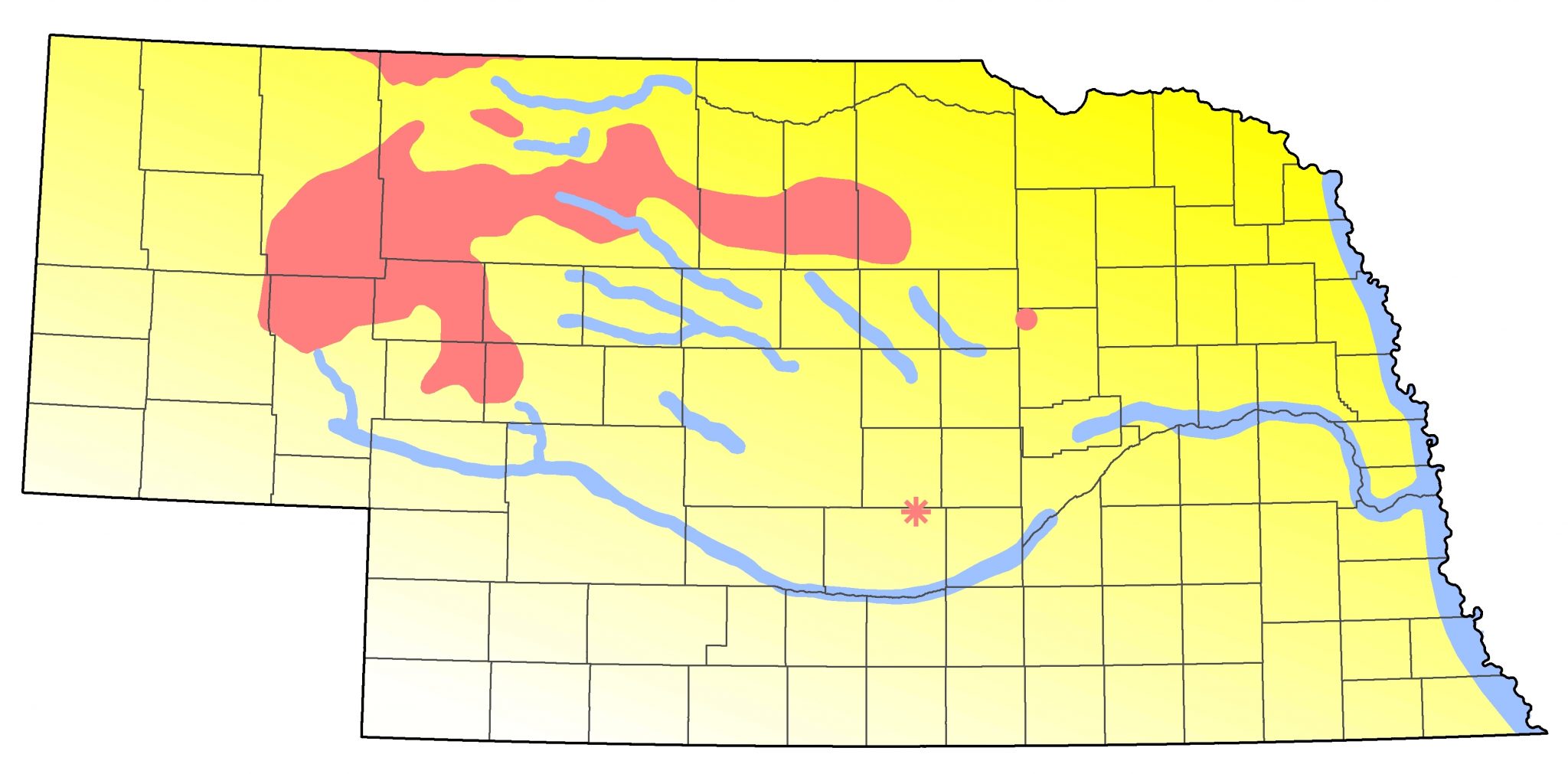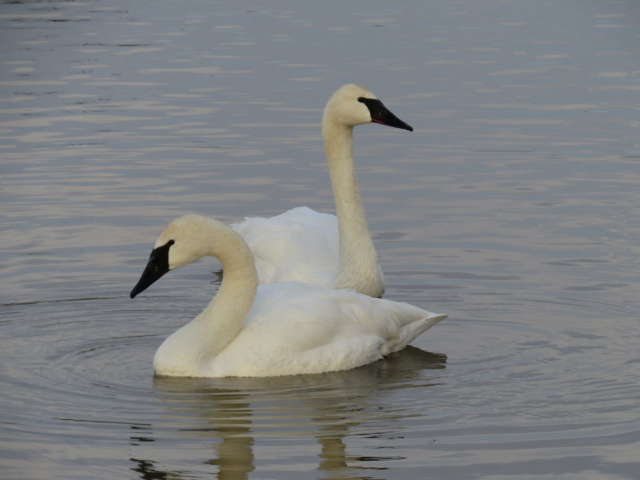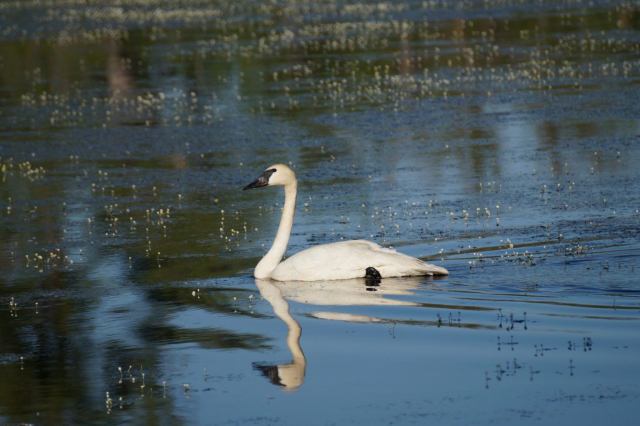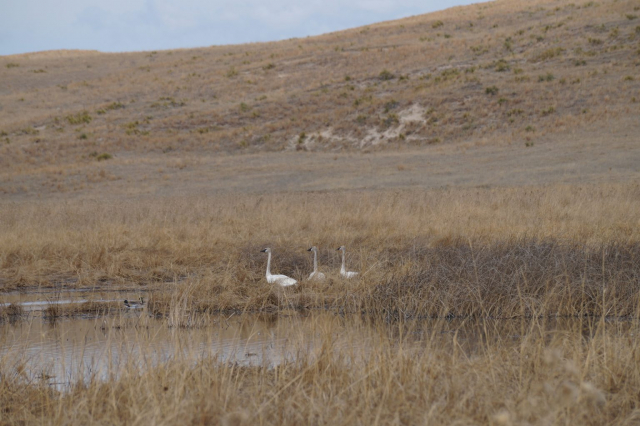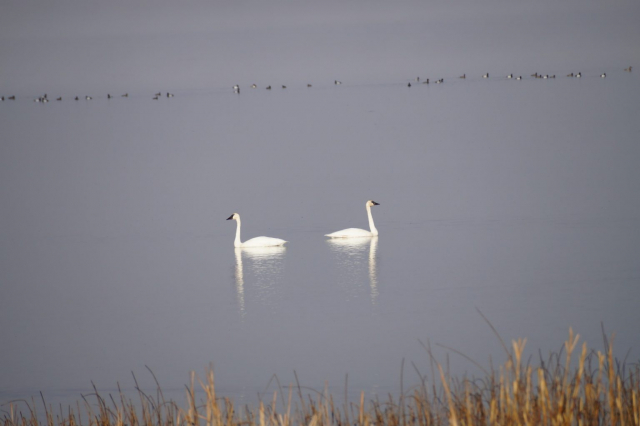Cygnus buccinator
Status: Increasing. Locally common, regular spring and fall migrant and winter visitor statewide, rare southwest. Locally fairly common regular summer resident at Sandhills lakes, rare elsewhere.
Documentation: Specimen: HMM 573, circa 15 Mar 1898 Overton, Dawson Co.
Taxonomy: No subspecies are recognized (AviList 2025).
Breeding populations that are currently geographically isolated, as a result or artifact of reintroduction efforts, have been given unique names. Resident birds that breed and winter in Nebraska are considered part of the High Plains population or flock, and individuals from the Interior Population or flock, which breed as close as Iowa and Minnesota (Groves 2017), occur in Nebraska during winter, especially in the east.
A leucistic individual with orange legs and smudgy black bill was at a Grant Co ranch with 17 “normal” Trumpeters for a while through 14 Mar 2025 (Glenda Burgess, Boni Edwards, personal communications).
Spring: winter <<<>>> Apr 19, 20, 21 (away from breeding range)
Migration is associated with weather conditions but may begin as early as mid-Feb and last through mid-Apr, peaking in Mar. Wintering birds at Carter Lake, Omaha departed 10 Mar 2014 and 13 Mar 2015, but were absent by 18 Feb in 2016 and 11 Feb in 2017. First arrivals in the Sandhills in 2020 were the 10 at Smith Lake WMA, Sheridan Co 21 Mar. Immatures may lag behind adults; one was in Polk Co 23 Apr 2019 and another in Lancaster Co 28 Apr 2023, and, in 2020, three were in northern Knox Co 10 May and a juvenile was still there 31 May, two were at Wood Duck WMA, Stanton Co 26-29 Apr, and one was at Hansen WPA, Clay Co 26 Apr. A flock of 76 at Cody Lake, Cherry Co 31 Mar 2024 was composed mostly of juveniles, suggesting most adults had dispersed to breeding locations by then.
- High Counts: 62 at Snyder’s Bend, Thurston Co 15 Mar 2023, 53 near Columbus, Platte Co 12 Mar 2022, 50 near Fremont, Dodge Co 1 Mar 2022, and 40 at Calamus Reservoir, Loup Co 1 Mar 2022.
Summer: Trumpeter Swans apparently bred historically on Sandhills lakes of Nebraska and South Dakota in small numbers (Ducey 1988, Ducey 1999a) but were extirpated before the end of the 19th century. In 1960-63, cygnets from Red Rock Lakes NWR, Montana, were introduced to Lacreek NWR in South Dakota, and by 2008 this population, surveyed on its Lacreek NWR wintering grounds, totaled 639; about 90% of this population summers in the Nebraska Sandhills (Vrtiska and Comeau 2009). The estimated number of resident Trumpeter Swans in Nebraska has increased from 200 individuals in 2000 to 311 individuals in 2015 (Groves 2017), with more recent surveys showing Nebraska may have more than 700 resident Trumpeter Swans (Mark P. Vrtiska, personal communication).
Away from the Sandhills, breeding is rare; breeding was noted in 2009-2010 on a small pond near Ravenna in Buffalo Co. A pair of adults with two flightless young was photographed there 29 Jul 2009; the family group remained at the site through at least 20 Oct, and presumably the same pair bred there successfully again in 2010. Since then, breeding has been successful most years; two adults with two cygnets were present 26 Jun 2017 and two adults first reported 4 May 2018 had two very young cygnets 17 Jun. In 2019, however, only one adult was present, and in 2020 two were there 17 Mar -16 Jul, but no young were seen. In 2021, two adults were present 13 Apr-26 Jun, but no evidence of nesting was found. In 2022 two adults were present 15 May, and one adult 15 May 2024. Two adults were present 14 Apr 2025.
Additional reports of breeding or likely breeding in areas peripheral to the Sandhills are recent. A pair on Overton Lake, Holt Co 15 Apr 2015 was “apparently nesting”. A pair may have nested on Beaver Creek in extreme northwestern Boone Co in 2018. A small population may be establishing along the Elkhorn River in Antelope and Madison Cos between Yellowbanks WMA and Ewing; the 13 reports are from 11 May-25 Aug beginning 16 May 2017 with a territorial pair near Clearwater. A family group of seven, possibly local breeders, was at Hackberry Creek WMA, Antelope Co 14 Sep 2020.
An unbanded pair on a small playa near Colon, Saunders Co 16 Apr 2011 was still present and seen mating through 11 May, and two adults were at a pond in western Douglas Co 25 Jun-15 Aug 2013, but no direct evidence of breeding was noted at either location.
Summer reports Jun-Aug of unbanded birds away from breeding areas include three on the lower Platte River near Venice, Douglas Co 6 Jun 2009, one at Hansen WPA, Clay Co 16 Jun 1999 (Jorgensen 2012), one at North Lakes Basin, Seward Co 19 Jun 2014, an adult at North Platte SL, Lincoln Co 20 Jun 2006, and singles, possibly the same bird, in Douglas Co 28 Jun and 12 Aug 2013. One or two flight-capable birds were near Gretna, Sarpy Co for about four years through at least 4 Aug 2013; one of these may have been the bird at Prairie Queen RA, Sarpy Co May-Jul 2017.
- Breeding phenology:
Territorial Pairs: 7 Feb.
Eggs/Incubation: 23 Mar-3 Jun.
Nestlings: 21 May-10 Jun (Mollhoff 2022).
Dependent Fledglings: 25 May-13 Sep.
Fall: Oct 31, 31, Nov 1 (away from breeding range) <<<>>> winter
Migration is generally associated with weather conditions and usually does not begin until mid-Nov, although there are 12 earlier dates away from the breeding range 1 Sep-25 Oct. A large group for the early date was the 72 in Lincoln Co 27 Oct 2020.
- High counts: 288 along West Suburban Road, North Platte, Lincoln Co 25 Nov 2022, 140 near Ashby, Grant Co 29 Nov 2024, 130 at Long Lake, Lincoln Co 28 Nov 2023, and 91 at Mud Lake, Cherry Co 30 Nov 1998 (Ducey 1999b).
Winter: Until the 1980s, most Nebraska Trumpeter Swans were summer residents in the Sandhills and wintered at Lacreek NWR, South Dakota (Baldassarre 2014). By the 1980s, however, Trumpeter Swans were observed wintering locally in Nebraska, likely in response to increasing numbers and limited open water at Lacreek NWR. Currently, migration includes short distance movements of resident birds of the High Plains flock and longer distance movements of birds of the Interior Population. A Trumpeter Swan outfitted with a satellite transmitter and its family group wintered 23 Dec 2020-3 Mar 2021 near the Kansas-Oklahoma border southeast of Dodge City, Kansas (Anna Buckardt Thomas [Iowa DNR], personal communication; Mark P. Vrtiska, personal communication). Earlier, an Iowa trumpeter swan wintered as far south as Oklahoma during the winter of 1998-99, and another wintered near Heber Springs, Arkansas in 1999-2000 (https://www.iowadnr.gov/Conservation/Iowas-Wildlife/Wildlife-Species-Restoration).
As a result of local and regional increases, wintering resident birds and more recently migrants from the Minnesota population have become locally common in Nebraska, especially since the early 2000s. The number of Trumpeter Swans counted during mid-winter waterfowl surveys was less than 200 prior to 2000 but counts have exceeded 700 in recent years (Johnson et al 2017). The increasing numbers of wintering birds in eastern Nebraska correspond with increases in Minnesota and Iowa and some of these Nebraska sightings are of birds with red neck collars from the Iowa re-introduction program and orange patagial tags from the Minnesota program. Since 2014, though, red neck collars with satellite transmitters have also been placed on 24 Trumpeter Swans in the Nebraska Sandhills (Mark P. Vrtiska, personal communication; see Comments).
As of 2021-2022, numbers reported in winter continue to increase. See Large increase in number of wintering Trumpeter Swans in Nebraska 2013-2023.
Traditional Nebraska wintering sites include Blue Creek in Garden Co, the Snake River in Cherry Co, portions of the Loup River system, and the North Platte River at Lake Ogallala, Keith Co (Rosche 1994; Ducey 1999b, Vrtiska and Comeau 2009). However, as numbers have increased rapidly in the 2000s, presumably as a result of establishment and growth of the Interior Population, flocks are being reported in the east at locations where open water is reliably available. Regular wintering locations include Carter Lake, Omaha, sand and gravel mine lakes near Ashland, Saunders Co, and DeSoto NWR, Washington Co. During winter 2016-2017, first arrivals at Carter Lake were 11 on 22 Dec, peak count was 103 on 21 Jan, and numbers declined rapidly from mid-Feb, with 74 on 5 Feb but only 14, the last report, on 12 Feb.
- High counts: 315 along Garden County Road 44 east of US 26 on 19 Jan 2024, 250 at Lovitt Lake, Logan Co 2 Feb 2025, 243 on North River Road, North Platte, Lincoln Co 7 Jan 2022, 230 at Hansen Reservor, Lincoln Co 13 Jan 2024, 221 near Valley, Douglas Co 2 Jan 2923, and 220 at DeSoto NWR, Washington Co 26 Feb 2022.
Comments: Trumpeter Swans are occasionally kept in captivity; two have been kept at Cody Park, North Platte, Lincoln Co for several years and are sometimes erroneously reported as wild birds.
Images
Abbreviations used in text
HMM: Hastings Municipal Museum
NWR: National Wildlife Refuge
RA: Recreation Area
SL: Sewage Lagoons
WMA: Wildlife Management Area (State)
WPA: Waterfowl Production Area (Federal)
Acknowledgement
Mark P. Vrtiska provided numerous helpful comments that improved this species account.
Literature Cited
AviList Core Team, 2025. AviList: The Global Avian Checklist, v2025. https://doi.org/10.2173/avilist.v2025.
Baldassarre, G. 2014. Ducks, geese, and swans of North America. Johns Hopkins University Press, Baltimore, Maryland, USA.
Ducey, J.E. 1988. Nebraska birds, breeding status and distribution. Simmons-Boardman Books, Omaha, Nebraska, USA.
Ducey, J.E. 1999a. History and Status of the Trumpeter Swan in the Nebraska Sand Hills. North American Swans 28: 31-39.
Ducey, J.E. 1999b. Trumpeter Swans in Nebraska Sandhills. Trumpetings 9: 2.
Groves, D.J. 2017. The 2015 North American Trumpeter Swan Survey. U.S. Fish and Wildlife Service Division of Migratory Bird Management, Juneau, Alaska, USA.
Johnson, H.M., L. Reichart, and M.P. Vrtiska. 2017. Trumpeter Swans in the Nebraska Sandhills – Initial Insights. Power point presentation on the Rainwater Basin Joint Venture website.
Jorgensen, J.G. 2012. Birds of the Rainwater Basin, Nebraska. Nebraska Game and Parks Commission, Lincoln, Nebraska, USA.
Mollhoff, W.J. 2022. Nest records of Nebraska birds. Nebraska Ornithologists’ Union Occasional Paper Number 9.
Rosche, R.C. 1994. Birds of the Lake McConaughy area and the North Platte River valley, Nebraska. Published by the author, Chadron, Nebraska, USA.
Vrtiska, M.P., and S. Comeau. 2009. Trumpeter Swan survey of the High Plains flock, Interior Population winter 2008. Unpublished report, Nebraska Game and Parks Commission Lincoln, Nebraska, and U.S. Fish and Wildlife Service, Lacreek NWR, Martin, South Dakota, USA.
Recommended Citation
Silcock, W.R., and J.G. Jorgensen. 2025. Trumpeter Swan (Cygnus buccinator). In Birds of Nebraska — Online. www.BirdsofNebraska.org
Birds of Nebraska – Online
Updated 3 Sep 2025
